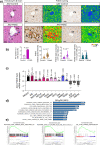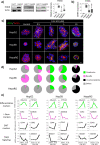PI3Kδ activity controls plasticity and discriminates between EMT and stemness based on distinct TGFβ signaling
- PMID: 35879421
- PMCID: PMC9314410
- DOI: 10.1038/s42003-022-03637-w
PI3Kδ activity controls plasticity and discriminates between EMT and stemness based on distinct TGFβ signaling
Abstract
The stem cells involved in formation of the complex human body are epithelial cells that undergo apicobasal polarization and form a hollow lumen. Epithelial plasticity manifests as epithelial to mesenchymal transition (EMT), a process by which epithelial cells switch their polarity and epithelial features to adopt a mesenchymal phenotype. The connection between the EMT program and acquisition of stemness is now supported by a substantial number of reports, although what discriminates these two processes remains largely elusive. In this study, based on 3D organoid culture of hepatocellular carcinoma (HCC)-derived cell lines and AAV8-based protein overexpression in the mouse liver, we show that activity modulation of isoform δ of phosphoinositide 3-kinase (PI3Kδ) controls differentiation and discriminates between stemness and EMT by regulating the transforming growth factor β (TGFβ) signaling. This study provides an important tool to control epithelial cell fate and represents a step forward in understanding the development of aggressive carcinoma.
© 2022. The Author(s).
Conflict of interest statement
The authors declare no competing interests.
Figures







Similar articles
-
Intrinsic cancer cell phosphoinositide 3-kinase δ regulates fibrosis and vascular development in cholangiocarcinoma.Liver Int. 2023 Dec;43(12):2776-2793. doi: 10.1111/liv.15751. Epub 2023 Oct 7. Liver Int. 2023. PMID: 37804055
-
Transforming growth factor-β-induced plasticity causes a migratory stemness phenotype in hepatocellular carcinoma.Cancer Lett. 2017 Apr 28;392:39-50. doi: 10.1016/j.canlet.2017.01.037. Epub 2017 Feb 2. Cancer Lett. 2017. PMID: 28161507
-
Network modeling of TGFβ signaling in hepatocellular carcinoma epithelial-to-mesenchymal transition reveals joint sonic hedgehog and Wnt pathway activation.Cancer Res. 2014 Nov 1;74(21):5963-77. doi: 10.1158/0008-5472.CAN-14-0225. Epub 2014 Sep 4. Cancer Res. 2014. PMID: 25189528 Free PMC article.
-
Reprogramming during epithelial to mesenchymal transition under the control of TGFβ.Cell Adh Migr. 2015;9(3):233-46. doi: 10.4161/19336918.2014.983794. Epub 2014 Nov 17. Cell Adh Migr. 2015. PMID: 25482613 Free PMC article. Review.
-
Regulation of Hepatocellular Carcinoma Epithelial-Mesenchymal Transition Mechanism and Targeted Therapeutic Approaches.Adv Exp Med Biol. 2024;1450:93-102. doi: 10.1007/5584_2023_781. Adv Exp Med Biol. 2024. PMID: 37452258 Review.
Cited by
-
Hepatocellular-Carcinoma-Derived Organoids: Innovation in Cancer Research.Cells. 2024 Oct 18;13(20):1726. doi: 10.3390/cells13201726. Cells. 2024. PMID: 39451244 Free PMC article. Review.
-
Opportunities and challenges of hepatocellular carcinoma organoids for targeted drugs sensitivity screening.Front Oncol. 2023 Jan 6;12:1105454. doi: 10.3389/fonc.2022.1105454. eCollection 2022. Front Oncol. 2023. PMID: 36686807 Free PMC article. Review.
References
Publication types
MeSH terms
Substances
LinkOut - more resources
Full Text Sources
Medical
Molecular Biology Databases
Miscellaneous

